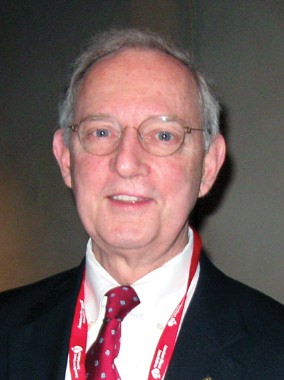ORLANDO – After 5-years of follow-up, the largest randomized trial done to date of stem cells placed into patients’ hearts following an acute myocardial infarction showed stable but modest improvement in ejection fraction as well as significant improvement in a combined clinical end point, a finding made possible by the lengthy follow-up.
"The improvement in global left ventricular function was sustained over 5 years, due to profound recovery of contractile function in infracted segments 5 years after administration of bone marrow cells," Dr. David M. Leistner said at the annual scientific sessions of the American Heart Association.
He reported 5-year follow-up data on 200 of the 204 acute MI patients initially enrolled in the Remodeling in Acute Myocardial Infarction (REPAIR-AMI) study, which randomized patients 3-7 days after successful reperfusion to receive an intracoronary infusion of autologous progenitor, mononuclear bone marrow cells (BMC) infused into the patient’s infarct-related artery, or a placebo infusion.
After 5 years, 16 BMC recipients who underwent measurement of their left ventricular ejection fraction had an average 5.9% improvement, compared with their baseline levels. In contrast, the 10 placebo patients who underwent ejection-fraction measurement at the 5-year follow-up had an average 3.3% decline in ejection fraction, compared with their baseline level, a statistically significant difference compared with the BMC-treated patients. These ejection fraction changes relative to baseline closely matched the 4-month follow-up findings, the primary end point from REPAIR-AMI, that the researchers previously reported (N. Engl. J. Med. 2006;355:1210-21).
Dr. Leistner and his associates had 5-year follow-up data for the clinical outcomes of 100 of the 101 patients originally randomized to BMC treatment and for 100 of the 103 patients originally in the placebo control group. After 5 years, the combined rate of death, MI, or need for revascularization was 64% in the placebo patients and 42% in the BMC patients, a statistically significant difference in a prespecified end point.
In a multivariate analysis, the patient’s change in left ventricular ejection infraction at 4 months after treatment was the only measured variable to significantly link with this combined clinical outcome. Patients with significant ejection fraction improvement after 4 months had a 19% reduced rate of the combined clinical end point event at 5 years, said Dr. Leistner, a cardiologist at Goethe University in Frankfurt am Main, Germany.
The 5-year clinical follow-up also showed suggestive trends of reduced rates of death from congestive heart failure and reduced heart failure hospitalization among the BMC patients. Three of the control patients and none of the BMC patients died from heart failure, and nine control patients and five BMC patients required hospitalization for heart failure during the follow-up period, he said.
The prolonged follow-up also showed no signs of increased rates of cancer, cardiac arrhythmia, syncope, or need for a pacemaker or implantable cardioverter defibrillator. "Initially, we were apprehensive about these potential adverse events," Dr. Leistner said.
A MRI assessment done in a subgroup of 16 BMC and 10 control patients also showed significantly more systolic wall thickening in the BMC-treated patients compared with the controls, extending an observation first made at the 4-month follow-up.
Based on these promising outcomes, the Frankfurt group will launch in January a new study of the same treatment protocol that plans to randomize about 3,000 patients and will have clinical outcomes after 2-3 years as the study’s primary end point. It will also include a MRI substudy that may be large enough to address how the BMC infusion acts, Dr. Leistner said.
The Bone Marrow Cells in Acute Myocardial Infarction (BAMI) study will be run at several centers throughout Europe, with funding coming from the European Union, said the lead investigator for this program, Dr. Andreas M. Zeiher, professor and chairman of the department of medicine at Goethe University.
Dr. Zeiher noted that several research groups have reported results from about 20 studies of stem cell therapy delivered into the myocardium of acute MI patients in an effort to improve ejection fraction and prevent heart failure development. Not only is the REPAIR-AMI study the largest of these and the one with the longest reported follow-up, but it is one of only four studies to report treatment efficacy.
A key problem with many of the failed studies was their use of heparin during delivery of the cells into the coronary circulation, Dr. Zeiher said in an interview.
Heparin treatment completely blocks the ability of cells to respond to cytokines and to enter the myocardium from coronary blood. Heparin-treated cells pass through the heart without adhering. The Frankfurt protocol uses heparin when withdrawing bone marrow cells, but after the researchers separate out the mononuclear cells they use serum to neutralize the heparin. When the cells are infused into the coronary circulation no heparin is used in the cell mixture nor is heparin administered to the patient. To prevent clotting during the treatment catheterization, the Frankfurt group administers bivalirudin, he explained.



